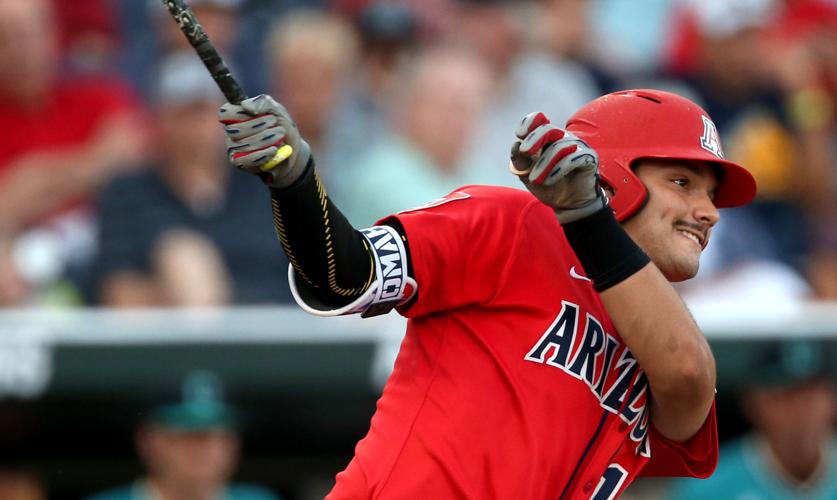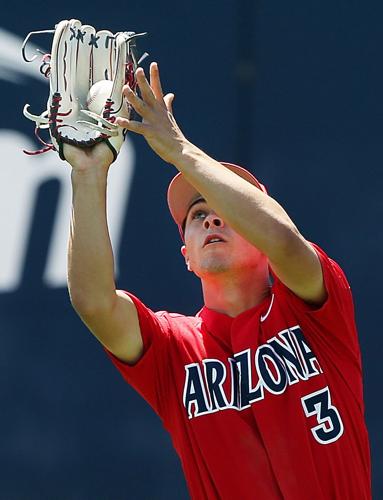Jay Johnson had a smile on his face when he emerged from his office last week. His Arizona Wildcats weren’t headed back to the College World Series, but Johnson had reason to be optimistic about the future of the program.
The just-concluded MLB draft had been a “massive success,” Johnson said. Most of Arizona’s top pro prospects got picked within projected parameters; most of the players Johnson and his staff were hoping to keep decided to postpone their pro plans.
The latter marked a significant step in Johnson’s plan for sustained success. He and the Wildcats came flying out of the box in Year 1, making it to the CWS finals last June. They had what minimally could be termed a quality at-bat in Year 2, making the NCAA Tournament for the second season in a row.
Now comes the next challenge: becoming a legitimate annual threat to make it to Omaha. Johnson views the events of last week as critical to that process.
“It doesn’t matter who you have on signing day,” Johnson said. “It matters who’s in the locker room the day of the first meeting.”
So what might the 2018 Wildcats look like? A lot like the ’17 Wildcats, with the potential to exceed them.
On paper, offense remains the strength of the team. Arizona had by far the most potent lineup in the Pac-12 last season and loses its centerpiece, All-American and league batting champion JJ Matijevic. The Wildcats also lose all-Pac-12 center fielder Jared Oliva.
But Johnson believes the Wildcats’ lineup could be deeper next season.
“You’re not going to replace JJ’s production,” Johnson said. “That’s one of the best seasons this university has ever seen, and that’s saying a lot. The goal is, can we be better at the eight other spots?”
Matijevic and Oliva took big leaps as juniors, and Johnson is counting on similar growth from the returning hitters who likely will form the regular 2018 lineup.
As a sophomore, Alfonso Rivas nearly matched Matijevic, batting .371 with seven home runs, 63 RBIs, 54 runs and a .483 on-base percentage. Rivas, who mainly served as the DH this season, likely will succeed Matijevic at first base.
Rivas’ best buddy, Cesar Salazar, returns at catcher, where he provides stellar defense and leadership along with clutch hitting. Salazar hit .284 as a sophomore with an OBP of .373.
Outfielder Cal Stevenson and third baseman Nick Quintana also return after promising first seasons at Arizona. Stevenson, a transfer who will be a senior in 2018, started slowly but finished strong, batting .311 and leading the Wildcats in runs (61) and walks (48). Quintana, a freshman in ’17, cooled after a hot start but showed major power potential with 17 doubles and six homers.
Quintana’s classmates, infielder Cameron Cannon and outfielder Matt Fraizer, are expected to join him in next year’s starting lineup. Cannon started 27 games as a freshman, mostly at second base, and hit .274 with as many walks as strikeouts (nine apiece).
Cannon’s double-play partner could be transfer Travis Moniot. The switch-hitter started 53 games as a freshman at Oregon in 2016.
He hit just .168 but had five home runs. Moniot hit .353 with seven homers, 17 stolen bases and a .524 on-base percentage at Orange Coast College this season.
Johnson is hopeful newcomers can supplement what has the makings of a good pitching staff, or at least the nucleus of one. The ’17 Wildcats never developed the pitching depth needed to become a regional host or advance deep in the postseason, and pitching again appears to be the team’s biggest question mark heading into next year.
Arizona loses its top two starters, left-handers JC Cloney and Cameron Ming, who combined to go 14-4. The Wildcats retain two ready-made replacements: right-handers Cody Deason and Michael Flynn. The two served multiple roles as sophomores, combining for a 10-3 record with three saves. They’re expected to anchor the ’18 staff.
Other possible starters include talented but inconsistent left-hander Randy Labaut, who showed big-time flashes as a redshirt freshman; another lefty, JC transfer Avery Weems, whose raw stuff is better than that of Cloney and Ming, according to Johnson; and righty Tylor Megill, who struggled as a starter in his first year at the UA but carved a niche as a late-inning reliever (team-high three saves).
Arizona is throwing significant resources at the pitching problem, if you want to call it that. Ten newcomers are full- or part-time pitchers, bringing the total on the roster to 21.
“We know we have to get better in that area,” Johnson said. “This class was the first opportunity we had to recruit a higher level of pitcher, and in 2018 it gets even better. And in ’19, we’re on that track too. It takes time.
“I’m excited about the potential. With that being said, it’s only potential until you see it. It’s fair that there are some questions. It’s our job to develop those guys. I’m excited about the group that we can develop.”





